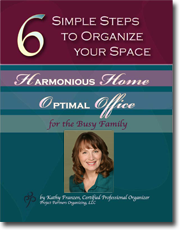So, you know your life is full of clutter — things you don’t need, things you don’t necessarily want, and way more than you’ll actually use. But where the heck did all this stuff come from?
It might be hard to pinpoint the exact moment when clutter invaded and took over your life. Maybe you grew up in a cluttered household, so living with an overabundance of “things” has always felt natural. Or perhaps clutter is just beginning to form. (In which case, it’s time to nip it in the bud!)
Why are some people more prone to clutter than others? Following are a few reasons. If you see yourself in any of these scenarios, take heart. By recognizing what leads you to accumulate clutter you can make the transition to a clutter-free life.
You inherited it from your parents: If your parents were packrats, you can thank them for your love of abundance. And as you continue your life full of clutter, consider the fate you are dealing your loved ones if you don’t attempt to change. Your children might continue the cycle of clutter, or you may drive your mate and friends crazy.
You might need it “someday”: Back in the days of the Great Depression and the World Wars, people justifiably saved just about everything because of scarcity and rationing. However, in this day and age, there is no reason to continue this thought pattern. Thinking something will come in handy “one day” is NOT reason enough to keep it. By letting go, you’ll find that most of the time you’ll never need those things again. And if you do, you’ll likely find similar (or better) things to replace them.
Clutter is part of your identity: Is your identity somehow related to your possessions? Or, are you overly sentimental about your things? Remember that even if you get rid of the clutter, you still have the great memories associated with specific items. Allow yourself to release unloved or unuseful gifts from well-meaning friends and family. You are not throwing away your friends’ kindness or love; you are simply releasing the unneeded items to make room for the things that matter most to you.
You’re bombarded by “more is better” reasoning by marketers: Do catalogs invade your mailbox? Are companies constantly trying to sell you the newest do-hickey, clothing, or home decor? Look around your kitchen and count your small appliances and gadgets. Most likely, they simply add clutter to your life, taking up space. Next time the urge to buy grabs you, ask yourself if it will REALLY make your life better.
Clutter fills a void in your life: Clutter can help to hide loneliness, anger, fear, and other important emotions. It fills time and space and keeps you focused on things other than your problems. When you free the clutter, you’ll free yourself to deal with the real issues around you. It may be tough at first, but the rewards are endless. Similarly, some people want to hide in their clutter. They use an abundance of “stuff” to hide or shelter themselves from the outside world. A good way to start getting back into the swing of life is to declutter just one room. You’ll still be able to retreat to your safe place, but the lack of clutter will begin to feel freeing rather than terrifying.
Of course, you may not see yourself in any of the above scenarios. Perhaps you’ve simply accumulated a little clutter in your life due to a shortage of time, too many work or family demands, or a lack of organizing skills. This is perfectly normal. Not everyone who defines her life as “cluttered” will fit into the above scenarios. But for those who know that clutter is seriously affecting their lives, the above reasons may help define the source and allow them to start the decluttering process.
Whatever the reasons you’ve accumulated clutter, once you recognize them, you can move forward and begin your new life.
© 2006 Articles on Demand™
 FREE E-Book: 6 Simple Steps to Organize Your Space
FREE E-Book: 6 Simple Steps to Organize Your Space